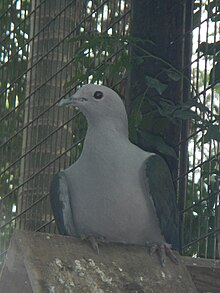
The green imperial pigeon is a large forest pigeon. The large range extends from Nepal, southern India and Sri Lanka eastwards to southern China, Indonesia and the Philippines.
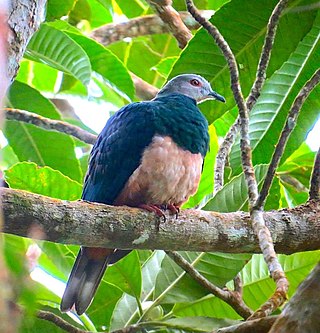
The pink-bellied imperial pigeon, also known as the zone-tailed pigeon, is found in the Philippines. It is a large and striking dove reaching sizes of up to 42cm long. The pink-bellied imperial pigeon is mostly dark green, with a pale gray head, an appropriately pink belly, and a brown, black, and gray pattern on its tail. Its eyes and eye ceres are red. Its natural habitat is tropical moist lowland forest. It is threatened by habitat loss.

The Polynesian imperial pigeon or Society Islands pigeon is a species of bird in the family Columbidae. It is endemic to French Polynesia. Its natural habitat is subtropical or tropical moist lowland forest and subtropical or tropical moist montane forest. It is threatened by habitat loss.
The Vanuatu imperial pigeon or Baker's imperial pigeon is a species of bird in the family Columbidae. It is endemic to Vanuatu and lives in forests. It is threatened by forest clearing, and the International Union for Conservation of Nature (IUCN) has assessed it as a vulnerable species.

The cinnamon-bellied imperial pigeon or cinnamon imperial pigeon is a species of bird in the family Columbidae. It is endemic to the northern Moluccas. Its natural habitat is subtropical or tropical moist lowland forests.
The chestnut-bellied imperial pigeon is a species of bird in the family Columbidae. It is endemic to the southern Solomon Islands.

The black imperial pigeon, also known as the Bismarck imperial pigeon, is a species of bird in the pigeon family, Columbidae. First described by English zoologist Philip Sclater in 1878, it is endemic to the Bismarck Archipelago, where it mainly inhabits rainforest and cloud forest in mountain areas above 500 m (1,600 ft). It is a large, heavily built imperial pigeon, with a length of 38–43 cm (15–17 in) and a weight of 661–665 g (23.3–23.5 oz). Adults are almost entirely black, except for the dark chestnut undertail coverts, the silvery-grey underside of the tail, and a pale grey scaly pattern on the wings and back. Both sexes look alike. Juveniles differ from adults in having paler undertail coverts.

The Mindoro imperial pigeon, also known as Mindoro zone-tailed pigeon, Great Mindoro pigeon or Pink-throated Imperial pigeon, is a bird species in the family Columbidae. It is endemic to the mountains of Mindoro in central Philippines and is the largest pigeon in the country reaching 50cm in length.

The Pacific imperial pigeon, Pacific pigeon, Pacific fruit pigeon or lupe is a widespread pigeon species in the family Columbidae. It is found in American Samoa, the Cook Islands, the smaller islands of eastern Fiji, Kiribati, Niue, the smaller satellite islands of Papua New Guinea, Samoa, Solomon Islands, Tokelau, Tonga, Tuvalu, Vanuatu, and Wallis and Futuna Islands.

The spectacled imperial pigeon is a species of bird in the family Columbidae. It is endemic to the Maluku Islands.

Pinon's imperial pigeon or Pinon imperial pigeon is a species of bird in the family Columbidae. It is found in New Guinea. The species is named after Rose de Freycinet née Pinon. Several subspecies have been designated:
The grey-headed imperial pigeon is a species of bird in the family Columbidae. It is endemic to Sulawesi in Indonesia. Its natural habitats are subtropical or tropical moist lowland forests and subtropical or tropical moist montane forests.

The pink-headed imperial pigeon is a species of bird in the family Columbidae found in the Lesser Sunda Islands of Indonesia. Its natural habitats are subtropical or tropical moist lowland forests, subtropical or tropical mangrove forests, and subtropical or tropical moist shrubland. It is threatened by habitat loss.

The black-bibbed cicadabird or black-bibbed cuckooshrike is a species of bird in the family Campephagidae. It is endemic to the Philippines. The species is elusive and poorly known. This species has five subspecies that differ considerably in plummage, it is possible that this may actually be a species complex and consists of multiple species.

The white-winged cuckooshrike, also known as white-winged cicadabird or white-winged graybird, is a species of bird in the family Campephagidae. It is endemic to the Philippines found on the islands of Negros, Panay and formerly on Guimaras. Some taxonomists place this species in the genus Analisoma.

The brown tit-babbler is a species of bird in the family Timaliidae. It is endemic to the Philippines. Its natural habitats are tropical moist lowland forest and or tropical moist montane forest.
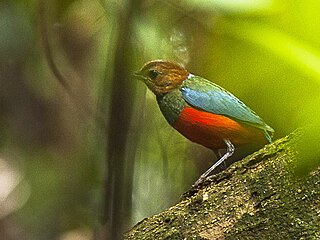
The Philippine pitta or blue-breasted pitta, is a species of bird in the family Pittidae. It is a striking and colorful with a red belly, black throat, a brown head, a blue chest, rump and tail. It is found in Indonesia and the Philippines. Its natural habitat is tropical moist lowland forest. It is part of the Red-bellied pitta species complex.
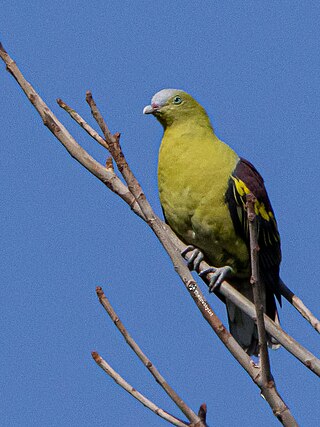
The Philippine green pigeon is a pigeon in the genus Treron. It is endemic to the Philippines where it lives in the tropical moist lowland forests. It is part of the pompadour green pigeon complex which it was once conspecific with.
The Geelvink imperial pigeon is a species of bird in the family Columbidae. It is endemic to Indonesia's Schouten Islands and Mios Num Island, which lie north of New Guinea. Its natural habitats are tropical moist lowland forests and mangrove forests.
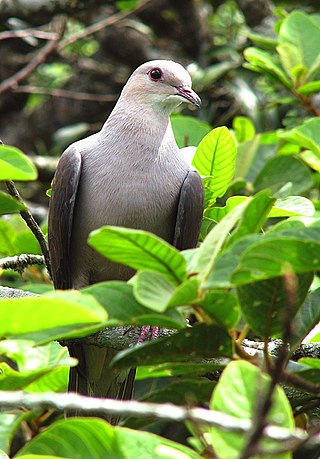
The Malabar imperial pigeon or Nilgiri imperial pigeon is a species of bird in the family Columbidae. It is endemic to the Western Ghats of India.


